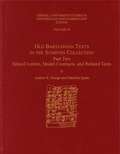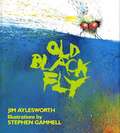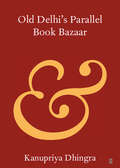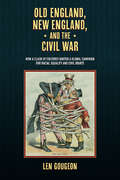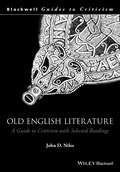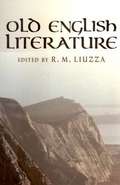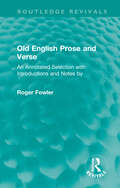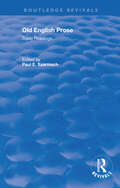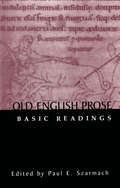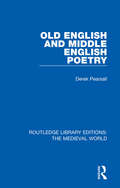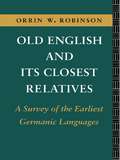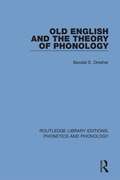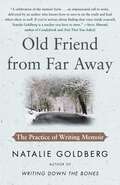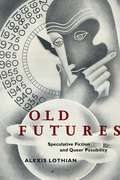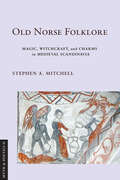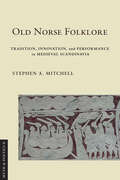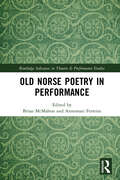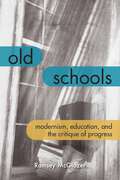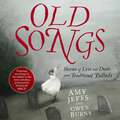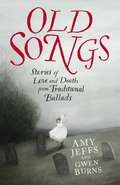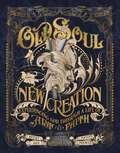- Table View
- List View
Old Babylonian Texts in the Schøyen Collection, Part Two: School Letters, Model Contracts, and Related Texts (CUSAS: Cornell University Studies in Assyriology and Sumerology #43)
by A. R. George Gabriella SpadaIn ancient Mesopotamia, men training to be scribes copied model letters in order to practice writing and familiarize themselves with epistolary forms and expressions. Similarly, model contracts were used to teach them how to draw up agreements for the transactions typical of everyday economic life. This volume makes available a trove of previously unknown tablets and fragments, now housed in the Shøyen Collection, that were produced in the training of scribes in Old Babylonian schools.Following on Old Babylonian Texts in the Schøyen Collection, Part One: Selected Letters, this volume publishes the contents of sixty-five tablets bearing Akkadian letters used to train scribes and twenty-six prisms and tablets carrying Sumerian legal texts copied in the same context. Each text is presented in transliterated form and in translation, with appropriate commentary and annotations and, at the end of the book, photographs of the cuneiform. The material is made easily navigable by a catalogue, bibliography, and indexes.This collection of previously unknown documents expands the extant corpus of educational texts, making an essential contribution to the study of the ancient world.
Old Black Fly
by Jim AylesworthNothing drives a family crazy faster than an old black fly on a hot summer day, especially when the family's a little crazy already. And this fly is as bad as they come. He knows every low-down trick in the book--and won't rest until he's gone through them all. He ate on the crust of the Apple pie. He bothered the Baby and made her cry. Shoo fly! Shoo fly! Shooo.
Old Bones and New Buds (Reach Into Phonics Ser.)
by Deborah J. Short María Alvarez Carlos VazquezNIMAC-sourced textbook
Old Books, New Technologies
by David MckitterickAs we rely increasingly on digital resources, and libraries discard large parts of their older collections, what is our responsibility to preserve 'old books' for the future? David McKitterick's lively and wide-ranging study explores how old books have been represented and interpreted from the eighteenth century to the present day. Conservation of these texts has taken many forms, from early methods of counterfeiting, imitation and rebinding to modern practices of microfilming, digitisation and photography. Using a comprehensive range of examples, McKitterick reveals these practices and their effects to address wider questions surrounding the value of printed books, both in terms of their content and their status as historical objects. Creating a link between historical approaches and the technologies of the future, this book furthers our understanding of old books and their significance in a world of emerging digital technology.
Old Delhi's Parallel Book Bazaar (Elements in Publishing and Book Culture)
by Kanupriya DhingraThis Element looks at Old Delhi's Daryaganj Sunday Book Market, popularly known as Daryaganj Sunday Patri Kitab Bazaar, as a parallel location for books and a site of resilience and possibilities. The first section studies the bazaar's spatiality - its location, relocation, and respatialisation. Three actors play a major role in creating and organising this spatiality: the sellers, the buyers, and the civic authorities. The second section narrativizes the biographies of the booksellers of Daryaganj to offer a map of the hidden social and material networks that support the informal modes of bookselling. Amidst order and chaos, using their specialised knowledge, Daryaganj booksellers create distinctive mechanisms to serve the diverse reading public of Delhi. Using ethnography, oral interviews, and rhythmanalysis, this Element tells a story of urban aspirations, state-citizen relations, official and unofficial cultural economies, and imaginations of other viable worlds of being and believing.
Old England, New England, and the Civil War: How a Clash of Cultures Ignited a Global Campaign for Racial Equality and Civil Rights
by Len GougeonThe first study to document how the Civil War brought about a bitter cultural and political conflict between Great Britain and the United States, a conflict that ignited a global struggle for racial equality and human rights.This study tells for the first time the story of a bitter cultural and political conflict that arose between the leading writers and intellectuals of Great Britain and the United States during the Civil War. The latter were virtually all New Englanders. Ralph Waldo Emerson was a central figure. The British side included such notables as Thomas Carlyle, Matthew Arnold, and John Ruskin. The conflict was focused on the viability of liberal democracy and the notion that "all men are created equal." The question was: What type of social, political, and cultural paradigm was best suited to ensure the advancement of civilization––one in which all have equal rights, regardless of race or class, or one where a small number of privileged white elites exercise a controlling power? The New Englanders embraced the former and the British the latter. The result was a bitter alienation that ignited a global campaign for racial equality and universal human rights.
Old English Literature and the Old Testament
by Manish Sharma Michael FoxIt would be difficult to overestimate the importance of the Bible in the medieval world. For the Anglo-Saxons, literary culture emerged from sustained and intensive biblical study. Further, at least to judge from the Old English texts which survive, the Old Testament was the primary influence, both in terms of content and modes of interpretation. Though the Old Testament was only partially translated into Old English, recent studies have shown how completely interconnected Anglo-Latin and Old English literary traditions are.Old English Literature and the Old Testament considers the importance of the Old Testament from a variety of disciplinary perspectives, from comparative to intertextual and historical. Though the essays focus on individual works, authors, or trends, including the Interrogationes Sigewulfi, Genesis A, and Daniel, each ultimately speaks to the vernacular corpus as a whole, suggesting approaches and methodologies for further study.
Old English Literature: A Guide to Criticism with Selected Readings (Blackwell Guides to Criticism)
by John D. NilesThis review of the critical reception of Old English literature from 1900 to the present moves beyond a focus on individual literary texts so as to survey the different schools, methods, and assumptions that have shaped the discipline. Examines the notable works and authors from the period, including Beowulf, the Venerable Bede, heroic poems, and devotional literature Reinforces key perspectives with excerpts from ten critical studies Addresses questions of medieval literacy, textuality, and orality, as well as style, gender, genre, and theme Embraces the interdisciplinary nature of the field with reference to historical studies, religious studies, anthropology, art history, and more
Old English Literature: Critical Essays
by R. M. LiuzzaRecognizing the dramatic changes in Old English studies over the past generation, this up-to-date anthology gathers twenty-one outstanding contemporary critical writings on the prose and poetry of Anglo-Saxon England, from approximately the seventh through eleventh centuries. The contributors focus on texts most commonly read in introductory Old English courses while also engaging with larger issues of Anglo-Saxon history, culture, and scholarship. Their approaches vary widely, encompassing disciplines from linguistics to psychoanalysis. In an appealing introduction to the book, R. M. Liuzza presents an overview of Old English studies, the history of the scholarship, and major critical themes in the field. For both newcomers and more advanced scholars of Old English, these essays will provoke discussion, answer questions, provide background, and inspire an appreciation for the complexity and energy of Anglo-Saxon studies.
Old English Metre
by Jun TerasawaOld English Metre offers an essential framework for the critical analysis of metrical structures and interpretations in Old English literature. Jun Terasawa's comprehensive introductory text covers the basics of Old English metre and reviews the current research in the field, emphasizing the interaction between Old English metre and components such as word-formation, word-choice, and grammar. He also covers the metre-related problems of dating, authorship, and the distinction between prose and verse.Each chapter includes exercises and suggestions for further reading. Appendices provide possible answers to the exercises, tips for scanning half-lines, and brief definitions of metrical terms used. Examples in Old English are provided with literal modern English translations, with glosses added in the first three chapters to help beginners. The result is a comprehensive guide that makes important text-critical skills much more readily available to Old English specialists and beginners alike.
Old English Prose and Verse: An Annotated Selection with Introductions and Notes by (Routledge Revivals)
by Roger FowlerOriginally published in 1966, this book provides students of the earliest stage of our literature with a selection of texts for a complete introductory course. All the principal poems and prose works in this literature are represented, including more generous extracts from Beowulf than are common in anthologies of this type. By omitting texts of primarily philological and historical interest it has been possible to include enough literary texts to satisfy all but the advanced student, who will follow this volume with the specialised editions available. A departure from the traditional design of Old English anthologies is the provision of full critical and annotative apparatus. In the past it has been necessary for students to go beyond their Readers, to specialised editions or to learned articles, in order to discover even the most basic information about the extracts or their content. Here each text is accompanied by an introduction which gives brief details of (where known) date, authorship, manuscript situation, character and critical interest. Line-by-line explanatory notes are also provided, and a bibliography of books and articles for further study. The glossary aims to be more explicit about form and meaning, and easier to use than those of earlier selections.
Old English Prose: Basic Readings
by Paul E. Szarmach and Deborah A. OosterhouseFirst published in 2001. With the decline of formalism and its predilection for Old English poetry, Old English prose is leaving the periphery and moving into the center of literary and cultural discussion. The extensive corpus of Old English prose lends many texts of various kinds to the current debates over literary theory and its multiple manifestations. The purpose of this collection is to assist the growing interest in Old English prose by providing essays that help establish the foundations for considered study and offer models and examples of special studies. Both retrospective and current in its examples, this collection can serve as a "first book" for an introduction to study, particularly suitable for courses that seek to entertain such issues as authorship, texts and textuality, source criticism, genre, and forms of historical criticism as a significant part of a broad, cultural teaching (and research) plan.
Old English Prose: Basic Readings (Basic Readings in Anglo-Saxon England #5)
by Paul E. Szarmach Deborah A. OosterhouseWith the decline of formalism and its predilection for Old English poetry, Old English prose is leaving the periphery and moving into the center of literary and cultural discussion. The extensive corpus of Old English prose lends many texts of various kinds to the current debates over literary theory and its multiple manifestations. The purpose of this collection is to assist the growing interest in Old English prose by providing essays that help establish the foundations for considered study and offer models and examples of special studies. Both retrospective and current in its examples, this collection can serve as a "first book" for an introduction to study, particularly suitable for courses that seek to entertain such issues as authorship, texts and textuality, source criticism, genre, and forms of historical criticism as a significant part of a broad, cultural teaching (and research) plan.
Old English and Middle English Poetry (Routledge Library Editions: The Medieval World #39)
by Derek PearsallOriginally published in 1977, Old English and Middle English Poetry provides a historical approach to English poetry. The book examines the conditions out of which poetry grew and argues that the functions that it was assigned are historically integral to an informed understanding of the nature of poetry. The book aims to relate poems to the intellectual and formal traditions by which they are shaped and given their being. This book will be of interest to students and academics studying or working in the fields of literature and history alike.
Old English and its Closest Relatives: A Survey of the Earliest Germanic Languages
by Orrin W. RobinsonThis accessible introductory reference source surveys the linguistic and cultural background of the earliest known Germanic languages and examines their similarities and differences. The Languages covered include: Gothic Old Norse, Old Saxon, Old English, Old Low Franconian, Old High German Written in a lively style, each chapter opens with a brief cultural history of the people who used the language, followed by selected authentic and translated texts and an examination of particular areas including grammar, pronunciation, lexis, dialect variation and borrowing, textual transmission, analogy and drift.
Old English and the Theory of Phonology (Routledge Library Editions: Phonetics and Phonology #4)
by Bezalel E. DresherFirst published in 1985. This title is a study in the synchronic and diachronic phonology and morphology of the Mercian dialect of Old English. It is particularly concerned with issues in the theory of phonology that have been the subject of the ‘abstractness controversy’, which developed in response to the theory of phonology put forward by Chomsky and Hale. This title will be of interest to students of English language and linguistics.
Old Friend from Far Away: The Practice of Writing Memoir
by Natalie Goldberg&“Memoir writers, buy this book, put it on your personal altar, or carry it with you as you traverse the deep ruts of your old road.&” —Tom Spanbauer, author of The Man Who Fell in Love with the Moon Old Friend from Far Away teaches writers how to tap into their unique memories to tell their story. Twenty years ago Natalie Goldberg&’s classic, Writing Down the Bones, broke new ground in its approach to writing as a practice. Now, Old Friend from Far Away—her first book since Writing Down the Bones to focus solely on writing—reaffirms Goldberg&’s status as a foremost teacher of writing, and completely transforms the practice of writing memoir. To write memoir, we must first know how to remember. Through timed, associative, and meditative exercises, Old Friend from Far Away guides you to the attentive state of thought in which you discover and open forgotten doors of memory. At once a beautifully written celebration of the memoir form, an innovative course full of practical teachings, and a deeply affecting meditation on consciousness, love, life, and death, Old Friend from Far Away welcomes aspiring writers of all levels and encourages them to find their unique voice to tell their stories. Like Writing Down the Bones, it will become an old friend to which readers return again and again.
Old Futures: Speculative Fiction and Queer Possibility (Postmillennial Pop #10)
by Alexis LothianFinalist, 2019 Locus Award for Nonfiction, presented by the Locus Science Fiction FoundationTraverses the history of imagined futures from the 1890s to the 2010s, interweaving speculative visions of gender, race, and sexuality from literature, film, and digital mediaOld Futures explores the social, political, and cultural forces feminists, queer people, and people of color invoke when they dream up alternative futures as a way to imagine transforming the present. Lothian shows how queer possibilities emerge when we practice the art of speculation: of imagining things otherwise than they are and creating stories from that impulse. Queer theory offers creative ways to think about time, breaking with straight and narrow paths toward the future laid out for the reproductive family, the law-abiding citizen, and the believer in markets. Yet so far it has rarely considered the possibility that, instead of a queer present reshaping the ways we relate to past and future, the futures imagined in the past can lead us to queer the present. Narratives of possible futures provide frameworks through which we understand our present, but the discourse of “the” future has never been a singular one. Imagined futures have often been central to the creation and maintenance of imperial domination and technological modernity; Old Futures offers a counterhistory of works that have sought—with varying degrees of success—to speculate otherwise. Examining speculative texts from the 1890s to the 2010s, from Samuel R. Delany to Sense8, Lothian considers the ways in which early feminist utopias and dystopias, Afrofuturist fiction, and queer science fiction media have insisted that the future can and must deviate from dominant narratives of global annihilation or highly restrictive hopes for redemption.Each chapter chronicles some of the means by which the production and destruction of futures both real and imagined takes place: through eugenics, utopia, empire, fascism, dystopia, race, capitalism, femininity, masculinity, and many kinds of queerness, reproduction, and sex. Gathering stories of and by populations who have been marked as futureless or left out by dominant imaginaries, Lothian offers new insights into what we can learn from efforts to imaginatively redistribute the future.
Old Norse Folklore: Magic, Witchcraft, and Charms in Medieval Scandinavia (Myth and Poetics II)
by Stephen A. MitchellThe second volume of Old Norse Folklore explores medieval and early modern Nordic magic and witchcraft, covering syncretism, continuity, survival, and the reconstruction of pagan beliefs and cultic practices in this last area of western Europe to be Christianized. This volume not only considers these issues but also pulls back the curtain on more obscure, yet important, corners of Nordic magico-religious tradition.In these chapters, Stephen A. Mitchell draws on materials from many different periods of the vast Nordic world, stretching from Greenland to the Baltic, and examines such diverse witnesses as sagas, judicial records, ballads, synodal statutes, runes, proverbs, church murals, leechbooks, and the language used to discuss magic and its actors. Old Norse Folklore addresses how theology helped to shape the Nordic magical world and how language can reveal this world, how magic was used as a practical matter in (and what it meant philosophically to) the medieval Nordic world, and how inherited traditions between and among the historically connected societies of northern Europe impacted cultural developments in late medieval Scandinavia.
Old Norse Folklore: Tradition, Innovation, and Performance in Medieval Scandinavia (Myth and Poetics II)
by Stephen A. MitchellThe medieval northern world consisted of a vast and culturally diverse region both geographically, from roughly Greenland to Novgorod and culturally, as one of the last areas of Europe to be converted to Christianity. Old Norse Folklore explores the complexities of this fascinating world in case studies and theoretical essays that connect orality and performance theory to memory studies, and myths relating to pre-Christian Nordic religion to innovations within late medieval pilgrimage song culture.Old Norse Folklore provides critical new perspectives on the Old Norse world, some of which appear in this volume for the first time in English. Stephen A. Mitchell presents emerging methodologies by analyzing Old Norse materials to offer a better understandings ofunderstanding of Old Norse materials. He examines, interprets, and re-interprets the medieval data bequeathed to us by posterity—myths, legends, riddles, charms, court culture, conversion narratives, landscapes, and mindscapes—targeting largely overlooked, yet important sources of cultural insights.
Old Norse Poetry in Performance (Routledge Advances in Theatre & Performance Studies)
by Brian McMahon Annemari FerreiraThis book presents a range of approaches to the study of Old Norse poetry in performance. The contributors examine both eddic and skaldic poems and consider the surviving evidence for how they were originally recited or otherwise performed in medieval Scandinavia, Iceland and at royal courts across Europe. This study also engages with the challenge of reconstructing medieval performance styles and examines ways of applying the modern discipline of Performance Studies to the fragmentary corpus of Old Norse verse. The performance of verse by characters who appear in the Old Icelandic saga tradition is also considered, as is the cultural value associated not only with the poems themselves but with their various means of transmission and reception. This book will be of great interest to students and scholars in the fields of Old Norse studies, Performance and Theatre History.
Old Schools: Modernism, Education, and the Critique of Progress (Lit Z)
by Ramsey McGlazerWinner: AAIS First Book PrizeOld Schools marks out a modernist countertradition. The book makes sense of an apparent anachronism in twentieth-century literature and cinema: a fascination with outmoded, paradigmatically pre-modern educational forms that persists long after they are displaced in progressive pedagogical theories.Advocates of progressive education turned against Latin in particular. The dead language—taught through time-tested means including memorization, recitation, copying out, and other forms of repetition and recall—needed to be updated or eliminated, reformers argued, so that students could breathe free and become modern, achieving a break with convention and constraint. Yet McGlazer’s remarkable book reminds us that progressive education was championed not only by political progressives, but also by Fascists in Italy, where it was an object of Gramsci’s critique. Building on Gramsci’s pages on the Latin class, McGlazer shows how figures in various cultural vanguards, from Victorian Britain to 1970s Brazil, returned to and reimagined the old school.Strikingly, the works that McGlazer considers valorize this school’s outmoded techniques even at their most cumbersome and conventional. Like the Latin class to which they return, these works produce constraints that feel limiting but that, by virtue of that limitation, invite valuable resistance. As they turn grammar drills into verse and repetitious lectures into voiceovers, they find unlikely resources for critique in the very practices that progressive reformers sought to clear away.Registering the past’s persistence even while they respond to the mounting pressures of modernization, writers and filmmakers from Pater to Joyce to Pasolini retain what might look like retrograde attachments—to tradition, transmission, scholastic rites, and repetitive forms. But the counter-progressive pedagogies that they devise repeat the past to increasingly radical effect. Old Schools teaches us that this kind of repetition can enable the change that it might seem to impede.
Old Songs: Stories of Love and Death from Traditional Ballads
by Amy Jeffs Gwen BurnsOld Songs fuses short stories, histories, lyrics and music in an enthralling reimagining of traditional folk ballads. Sunday Times Bestselling historian Amy Jeffs and her creative collaborators combine forces to create a rich compendium, singing of travel, mystery, magic and the essential urges of humanity. Featuring iterations of fairy tales and sinister descendants of Greek myths and bible stories, as well as a cast of lesser-known characters with names like Tam Lim, Child Wynd and Maisery, Old Songs threads a tapestry of Britain's landscape, history and cultures. At the base of hills we can visit to this day, elf queens kidnap hapless poets and carry them through rivers of blood; and at the foot of a tree whose offspring still stand in the forests of Northumberland, a girl mimes combing the hairless head of a dragon who was once her brother.In spellbinding tales of brown-skinned girls who danced on their lovers' graves, of golden-masted ships captained by the Devil, of fiddles that cried "Murder!", of men kidnapped by fairies and boys married at fourteen, we find narrative motifs as ancient as humanity itself.In the histories interconnecting the stories, we find the fantastical rooted in the everyday, bringing to light the real experiences of great swathes of people to whom such story-songs were not only familiar, but a way of escaping into the extraordinary and returning gratefully home. Bringing enchantment to familiar landscapes, ballads were created anew by each singer and passed down from fireside to fireside, at the knees of childhood nurses, in manuscripts and in early printed pamphlets. Now, ten stories are gathered here, beautifully recreated for modern readers.Praise for Amy Jeffs'This gorgeous book should live on the bookshelves in every house that cares about the idea of Britain, what is was and where it came from' The Times'A beautiful retelling of British myths and exquisitely illustrated too' Daily Express'I have fallen so completely in love with this book... just one of the finest, most covetable things around' Katherine Rundell'A thing of beauty' The Herald
Old Songs: Stories of Love and Death from Traditional Ballads
by Amy Jeffs Gwen BurnsOld Songs fuses short stories, histories, lyrics and illustrations in an enthralling reimagining of traditional folk ballads. Sunday Times Bestselling historian Amy Jeffs and Illustrator Gwen Burns combine forces to create a rich compendium, singing of travel, mystery, magic and the essential urges of humanity. Featuring iterations of fairy tales and sinister descendants of Greek myths and bible stories, as well as a cast of lesser-known characters with names like Tam Lim, Child Wynd and Maisery, Old Songs threads a tapestry of Britain's landscape, history and cultures. At the base of hills we can visit to this day, elf queens kidnap hapless poets and carry them through rivers of blood; and at the foot of a tree whose offspring still stand in the forests of Northumberland, a girl mimes combing the hairless head of a dragon who was once her brother.In spellbinding tales of brown-skinned girls who danced on their lovers' graves, of golden-masted ships captained by the Devil, of fiddles that cried "Murder!", of men kidnapped by fairies and boys married at fourteen, we find narrative motifs as ancient as humanity itself.In the histories interconnecting the stories, we find the fantastical rooted in the everyday, bringing to light the real experiences of great swathes of people to whom such story-songs were not only familiar, but a way of escaping into the extraordinary and returning gratefully home. Bringing enchantment to familiar landscapes, ballads were created anew by each singer and passed down from fireside to fireside, at the knees of childhood nurses, in manuscripts and in early printed pamphlets. Now, ten stories are gathered here, beautifully recreated for modern readers.Praise for Amy Jeffs'This gorgeous book should live on the bookshelves in every house that cares about the idea of Britain, what is was and where it came from' The Times'A beautiful retelling of British myths and exquisitely illustrated too' Daily Express'I have fallen so completely in love with this book... just one of the finest, most covetable things around' Katherine Rundell'A thing of beauty' The Herald
Old Soul, New Creation: Experiencing God through a Life of Art and Faith
by Jake WeidmannRenew your soul through the beauty of art and creativity. Certified as one of nine Master Penmen in the world, fine artist Jake Weidmann invites you to immerse yourself in the centuries-old tradition of communing with God through creative work in this incredible art-driven coffee table book highlighting ten of Jake's most renowned works.Whether you prefer a pen, a paintbrush, or an iPad, every creative endeavor you undertake is a testimony to how God made you in His image. As the youngest certified Master Penman in the world, Jake knows the dedication it takes to hone skill and refine talent to be a successful creator. But as an acclaimed painter and woodworker, Jake Weidmann also has firsthand experience of drawing near and relying on his Creator to guide his work. For the first time, Jake invites you into his artist's studio to see the Maker's steady hand at work in his life and art, and ultimately to inspire you to embrace God's calling over you, whatever it may be.Old Soul, New Creation features ten of Jake's creations, along with in-progress photographs and stories of the artistic and spiritual struggle behind each. This stunning book is ultimately a story of God&’s goodness, His faithfulness, and His loving calling—all of which you can experience when you embrace the talents God gives you. As you sink into the words and images of Old Soul, New Creation, you'll discover:Full-color photography of Jake's artwork—available in book form for the first time—along with original calligraphy and illustrations from the authorPersonal stories and biblical insights about experiencing transformation through your work and talentPrayers to encourage you to lean on God as you pursue your passions Old Soul, New Creation is for anyone who:Delights in fine art and beautiful craftsmanshipSeeks inspiration to forge ahead through artistic strugglesWants a deeper understanding of a theology of workLongs for creative Christian communityDesires richer purpose and spiritual depth in their creative pursuits Slow down, breathe, and let your spirit be renewed through the beauty of art and craftsmanship in Old Soul, New Creation. As Jake writes, "God is creating in you. How will you join Him?"
